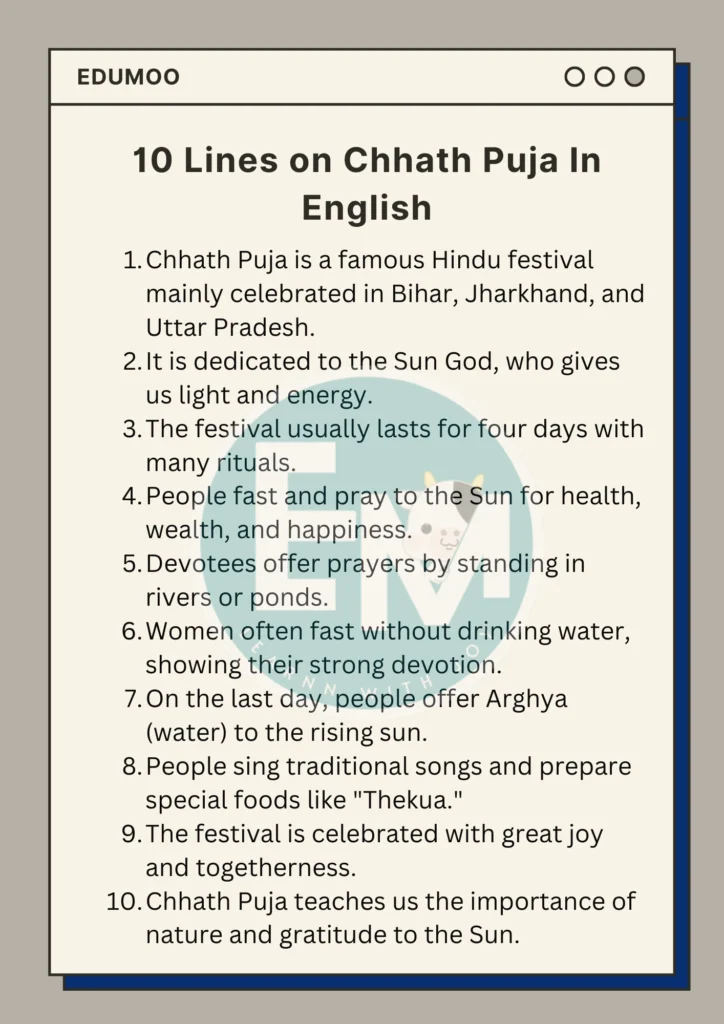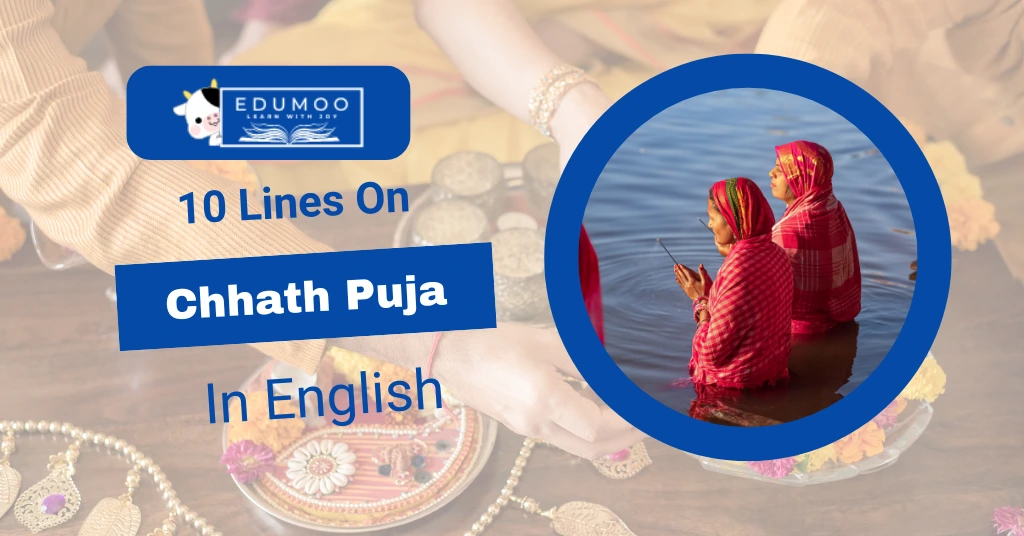Chhath Puja is a popular festival in India, especially in states like Bihar, Jharkhand, and Uttar Pradesh. This festival is dedicated to worshipping the Sun God, who gives us light and energy. During Chhath Puja, people pray for good health, happiness, and prosperity. The festival lasts for four days and includes fasting, standing in rivers, and offering prayers to the Sun. Many people prepare special foods and sing traditional songs. This festival is an expression of devotion and gratitude towards nature, teaching us to respect and thank the Sun for its blessings. Now, let’s check 10 Lines On Chhath Puja In English.
10 Lines On Chhath Puja In English
- Chhath Puja is a famous Hindu festival mainly celebrated in Bihar, Jharkhand, and Uttar Pradesh.
- It is dedicated to the Sun God, who gives us light and energy.
- The festival usually lasts for four days with many rituals.
- People fast and pray to the Sun for health, wealth, and happiness.
- Devotees offer prayers by standing in rivers or ponds.
- Women often fast without drinking water, showing their strong devotion.
- On the last day, people offer Arghya (water) to the rising sun.
- People sing traditional songs and prepare special foods like “Thekua.”
- The festival is celebrated with great joy and togetherness.
- Chhath Puja teaches us the importance of nature and gratitude to the Sun.

Essay On Chhath Puja In English In 300 Words
Chhath Puja is an important Hindu festival celebrated mainly in the states of Bihar, Jharkhand, and Uttar Pradesh. This festival is dedicated to worshipping the Sun God, known as Surya, who provides light and energy to the world. Chhath Puja usually lasts for four days and involves various rituals that show people’s devotion and respect for nature.
The festival begins with people cleaning their homes and purifying their surroundings. On the first day, known as “Nahay Khay,” people bathe in rivers or ponds and bring water home for cooking. On the second day, “Kharna,” devotees observe a fast, breaking it only after sunset with a simple meal. The third day is the most significant, as people observe a strict fast without even drinking water. In the evening, they gather near rivers or ponds and offer “Arghya,” or water, to the setting sun, praying for health, wealth, and happiness.
On the fourth and final day, people once again offer prayers to the rising sun. This act of praying to both the setting and rising sun is a unique aspect of Chhath Puja. During the festival, people prepare traditional dishes, like “Thekua,” a sweet treat made from wheat flour, jaggery, and ghee.
Chhath Puja is not just about rituals but also brings people together. Families, friends, and communities join in the celebrations, making it a time of unity and togetherness. People sing folk songs and wear new clothes, adding joy to the occasion. Chhath Puja teaches us the importance of the Sun and nature, as the Sun is essential for life on Earth.
In conclusion, Chhath Puja is a festival that celebrates faith, gratitude, and respect for nature. It reminds us of the Sun’s role in our lives and encourages us to be thankful for its energy and light. Celebrating Chhath Puja helps people connect with nature and understand the value of the Sun in a meaningful way.
| Also Read: 10 Lines on Bhai Dooj In English |
Essay On Chhath Puja In English In 1000 Words
Chhath Puja is a unique and ancient Hindu festival mainly celebrated in the states of Bihar, Jharkhand, and Uttar Pradesh. This festival is special because it is dedicated to worshipping the Sun God, known as Surya, and the goddess of dawn, Usha. The Sun is seen as a source of life, energy, and light for the world, and during Chhath Puja, people thank the Sun for these gifts. This festival is filled with devotion, rituals, and prayers and is celebrated with great enthusiasm by people of all ages.
The festival of Chhath Puja usually lasts for four days, with each day having its own importance and rituals. It typically falls in the month of October or November, just a few days after the festival of Diwali. People believe that praying to the Sun during Chhath Puja can bring happiness, prosperity, and good health to their families. This festival also teaches the values of purity, devotion, and respect for nature.
The first day of Chhath Puja is known as “Nahay Khay.” On this day, people clean their houses thoroughly to make their homes pure and ready for the festival. They also go to a river, pond, or any nearby water source to bathe. This bathing ritual is seen as a way of purifying the body and soul before starting the other rituals of Chhath Puja. After taking a bath, people bring some water from the river or pond to use in cooking special dishes for the festival. They eat simple, pure food on this day, as it marks the beginning of their preparations for the festival.
The second day of Chhath Puja is called “Kharna.” On this day, devotees observe a day-long fast without drinking even a sip of water. This fast shows their strong faith and devotion. In the evening, after sunset, they prepare a meal made from rice pudding (kheer) and chapatis, which they offer to the Sun God before eating. This meal is shared with family members and friends, who join in the prayers and celebrations. This day is important because it brings family members together, and they begin to feel the spirit of the festival.
The third day of Chhath Puja is considered the most important. It is called “Sandhya Arghya,” which means offering to the setting sun. On this day, devotees continue their fast, and they do not eat or drink anything for the whole day. In the evening, they gather at riverbanks, ponds, or other water bodies with their family and friends. They carry baskets filled with fruits, sweets, and other offerings for the Sun God. As the sun begins to set, devotees stand in the water, sometimes up to their waists, and offer their prayers to the setting sun.
This ritual of offering “Arghya” or water to the setting sun is beautiful and has a deep meaning. It represents the idea of gratitude and respect for the energy and light that the sun provides. By praying to the setting sun, devotees show their respect for the end of the day and the light that has guided them through it. People sing traditional songs and chant prayers during this ritual, which creates a very peaceful and spiritual atmosphere.
The fourth and final day of Chhath Puja is known as “Usha Arghya,” which means offering to the rising sun. Just before dawn, devotees return to the water bodies where they had gathered the previous evening. They stand in the water again, holding their baskets of offerings, and pray to the rising sun. This part of the ritual is very important, as the rising sun represents new beginnings, hope, and positivity. By offering their prayers to the rising sun, devotees seek blessings for a bright and prosperous future.
After this final prayer, the devotees end their fast by eating “prasad,” which is the food that was offered to the Sun God. This prasad is then shared with family members, friends, and neighbors. Eating the prasad together brings a sense of unity and joy among the people. Everyone celebrates the end of Chhath Puja with happiness, feeling blessed and thankful.
During Chhath Puja, people prepare special foods like “Thekua,” which is a sweet made from wheat flour, jaggery, and ghee. Thekua is considered a sacred offering and is placed in the baskets for the Sun God. Many other traditional sweets and dishes are also prepared, adding to the festive spirit. People sing folk songs that tell stories about the Sun God and the importance of nature. These songs are passed down from generation to generation and create a joyful and lively atmosphere during the festival.
Chhath Puja is more than just a festival; it is a reminder of the importance of nature and the environment. By worshipping the Sun, people show their respect for the natural resources that support life on Earth. The festival teaches the values of gratitude, respect, and unity. Through their fasting and prayers, devotees show the strength of their faith and the depth of their devotion. They believe that these rituals will bring them health, happiness, and prosperity.
The festival also brings families and communities together. People gather at rivers and ponds to celebrate, share food, and sing songs. This togetherness creates a sense of unity and harmony among the people. Chhath Puja reminds us that we are all connected to each other and to nature.
Chhath Puja is a beautiful festival filled with devotion, faith, and love for nature. It is a time when people come together to thank the Sun God for the blessings of life, health, and happiness. The rituals of Chhath Puja remind us of the importance of purity, dedication, and gratitude. By fasting, praying, and offering their respects to the Sun, people express their deep respect for the natural world. Chhath Puja is a festival that not only celebrates the Sun but also teaches us to value and protect the environment. Celebrating Chhath Puja brings peace, joy, and hope to people, making it a truly meaningful festival.
Conclusion
Today, we have learnt 10 lines on Chhath Puja. Chhath Puja is a beautiful festival that brings families and communities together. It reminds us of the importance of nature and how we depend on the Sun for life. By fasting and offering prayers, people express their deep respect and gratitude to the Sun God. Chhath Puja not only spreads joy but also inspires us to be thankful for nature’s gifts. Celebrating this festival helps us appreciate the role of the Sun in our lives and encourages us to respect and protect our environment.

